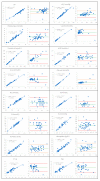Analytical Performances of the Novel i-STAT Alinity Point-of-Care Analyzer
- PMID: 36673107
- PMCID: PMC9857650
- DOI: 10.3390/diagnostics13020297
Analytical Performances of the Novel i-STAT Alinity Point-of-Care Analyzer
Abstract
Many Point-of-Care devices have been released over the past decade. However, data regarding their analytical performances in real-world situations remains scarce. Herein, we aimed to assess the analytical performances of the i-STAT Alinity system. We conducted an analytical performances study with the i-STAT Alinity device using cartridges CG4+ (pH, Pco2, Po2, lactate, bicarbonate and base excess); CHEM8+ (Na, K, Cl, ionized Ca, urea, creatinine, glucose, hematocrit and hemoglobin) and PT/INR (prothrombin time and international normalized ratio). We assessed the imprecision and compared the results to those obtained on existing instruments in the central laboratory. We found that the within-lab coefficients of variation (CV) were very low (<2%) or low (2−5%), except for creatinine and PT (CV = 5.2% and CV = 6.3%, respectively). For almost all the parameters, the results were strongly (R2 = 90−95%) or very strongly (R2 > 95%) correlated with those of the existing laboratory instruments, and the biases were very low (<2%) or low (2−5%). However, correlations of the PT and INR measurements with existing instruments were lower (R2 = 86.0% and 89.7%), and biases in the Po2 (7.9%), creatinine (5.4%) and PT (−6.6%) measurements were higher. The i-STAT Alinity appeared as a convenient device for measurements of numerous parameters. However, clinicians should interpret Po2, creatinine and PT results with caution.
Keywords: Point-of-Care Analyzer; analytical performance; blood gas; chemistry; coagulation; creatinine; hematology; i-STAT Alinity; lactate; urea.
Conflict of interest statement
This research was funded by Abbott Laboratories, which provided the devices, cartridges and quality control materials for this study. However, the funder had no role in the design of the study; in the collection, analyses or interpretation of the data; in the writing of the manuscript or in the decision to publish the results.
Figures

Similar articles
-
Comparison of point-of-care and central laboratory analyzers for blood gas and lactate measurements.J Clin Lab Anal. 2019 Jun;33(5):e22885. doi: 10.1002/jcla.22885. Epub 2019 Mar 29. J Clin Lab Anal. 2019. PMID: 30924550 Free PMC article.
-
Evaluation of the i-STAT Portable Clinical Analyzer for point-of-care blood testing in the intensive care units of a university children's hospital.Ann Clin Lab Sci. 2002 Summer;32(3):231-43. Ann Clin Lab Sci. 2002. PMID: 12175085
-
[The i-STAT analyzer. A new, hand-held device for the bedside determination of hematocrit, blood gases, and electrolytes].Anaesthesist. 1997 Aug;46(8):704-14. doi: 10.1007/s001010050457. Anaesthesist. 1997. PMID: 9382209 German.
-
Analytical and pre-analytical performance characteristics of a novel cartridge-type blood gas analyzer for point-of-care and laboratory testing.Clin Biochem. 2018 Mar;53:116-126. doi: 10.1016/j.clinbiochem.2018.01.007. Epub 2018 Jan 12. Clin Biochem. 2018. PMID: 29339078
-
Evaluation of the i-STAT Alinity v in a veterinary clinical setting.J Vet Diagn Invest. 2021 Jul;33(4):703-710. doi: 10.1177/10406387211019710. Epub 2021 May 28. J Vet Diagn Invest. 2021. PMID: 34047216 Free PMC article.
Cited by
-
Reliability of Capillary Blood Gas Measurements in Paralympic Sprinters at Rest: A Pilot Study.Sports (Basel). 2025 Jul 4;13(7):216. doi: 10.3390/sports13070216. Sports (Basel). 2025. PMID: 40711101 Free PMC article.
-
Maximizing the Clinical Value of Blood-Based Biomarkers for Mild Traumatic Brain Injury.Diagnostics (Basel). 2023 Oct 28;13(21):3330. doi: 10.3390/diagnostics13213330. Diagnostics (Basel). 2023. PMID: 37958226 Free PMC article. Review.
-
Validation of point-of-care tests used at in-home assessments among older adults in primary care.Scand J Prim Health Care. 2025 Jun;43(2):260-269. doi: 10.1080/02813432.2024.2426162. Epub 2024 Nov 11. Scand J Prim Health Care. 2025. PMID: 39526644 Free PMC article.
-
An RFID-Inspired One-Step Packaged Multimode Bio-Analyzer with Vacuum Microfluidics for Point-of-Care Diagnostics.Dig Tech Pap IEEE Int Solid State Circuits Conf. 2025 Feb;2025:352-354. doi: 10.1109/isscc49661.2025.10904714. Epub 2025 Mar 6. Dig Tech Pap IEEE Int Solid State Circuits Conf. 2025. PMID: 40144578 Free PMC article. No abstract available.
References
-
- Howayyer E., Alblooshi K., Almheiri N., Ali G., Turki F. Implementation of Point of Care Testing in the Emergency Department of a Teaching Hospital in U.A.E. J. Clin. Chem. Lab. Med. 2019;2:7.
-
- Lee M.-Y., Lim S.-F., Lam L. Evaluation of the I-STAT Alinity Point-of-Care Analyzer. Point Care. 2019;18:48–55. doi: 10.1097/POC.0000000000000190. - DOI
LinkOut - more resources
Full Text Sources
Miscellaneous

